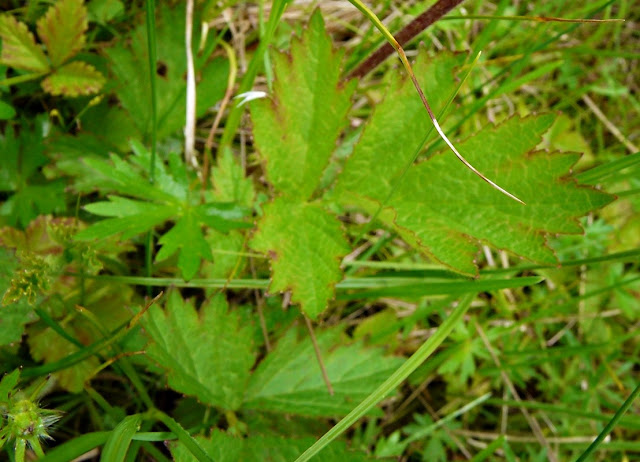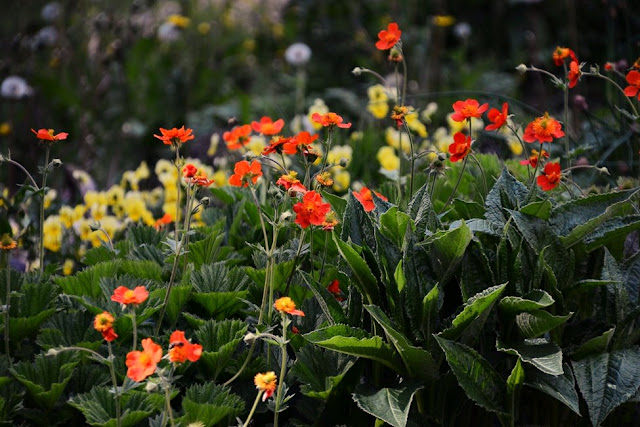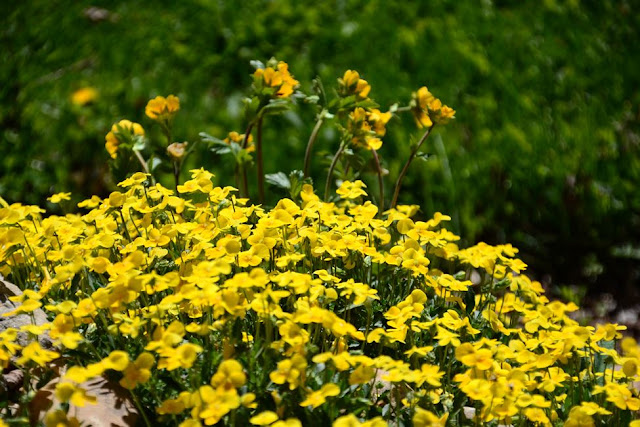 |
| Geum coccineum/ Scarlet Avens with Violas |
Geum is a genus in the Rose family, closely related to Fragraria/Strawberry and Potentilla/Cinquefoil. From Latin gaeum, it should perhaps be pronounced gay-oom but gee-um seems to be commonly used. Also commonly called Avens, a name whose ancient origin is unclear.
Traditionally, Geum urbanum, Blessed Herb-Herb Bennet (from herba benedicta) was used for a variety of medicinal and mystical functions. It is still used as an herb, but most of us are more likely to encounter the genus as garden plants or wildflowers. Generally, Geums/Avens are easy garden plants, at least in my more or less foothills climate (cold snowy winters, moderate not too dry summers), with no real problems or pest so far!
 |
| Geum aleppicum/ Yellow Avens with Violas |
I'm lucky to have a couple of species wild in my area: Geum rivale/Water Avens, which grows generally in mesic to wet areas, in full sun to full shade, and Geum aleppicum/ Yellow Avens, variable in habitat also, but tending to moist open areas. Interestingly, G. rivale is more common in the wild, but G. aleppicum is the one that has seeded itself into the yard in many places, and into garden beds as well, including sites much drier than what it occupies in the wild. It makes a handsome garden plant-- tall graceful stems (they seem to remain erect even in lower light conditions such as wet woods, though all my garden plants are in fairly sunny spots) which are much more floriferous for much longer than wild plants. The one caveat is that it will self-sow very abundantly, so while seed heads are attractive, it is best not to leave them too long! On the plus side, it is not especially hard to remove seedlings.
 |
| Geum aleppicum/Yellow Avens; flowers are not large, but they are bright on tall erect stems, and abundantly produced in the garden. |
Geum rivale/Water avens I have yet to try in the garden, though I suspect, like aleppicum, it will be less fussy about soil moisture than it is in the wild (many plants in the wild grow where they are best able to compete, rather than where they *must* grow), and I already know it will grow in any exposure. Most Geums have robust attractive foliage, and G. rivale has some of the nicest-- green and strong looking from early spring through snowfall (probably all winter in mild climates!). Leaves will tend to dark and bluer green in shade, and a brighter yellower green in full sun.
 |
| Geum rivale/Water Avens, in deep shade in wet woods. Foliage is lush, it will still flower, but flower stems will be floppy. |
 |
Geum rivale/Water Avens, growing in full sun.
|
 |
| Geum rivale/Water Avens wild in a sunny wetland area. |
 |
Geum rivale/Water Avens in sunny, moist roadside; note bright erect leaves, and erect flower stems.
|
So far I only have a couple of non-native Geums in the garden, though there are more I'd like to try- mostly wild species, but some cultivars for nice colour variants or longer flowering. Geum coccineum/Scarlet Avens varies in size depending on cultivar, many are described as small, but the form I grew from seed is a good size: the intense scarlet (red-orange) flowers are borne on at least 40cm flowering stems, with a slightly lower mound of dense substantial dark green foliage. These plants create a nearly impenetrable mat of old foliage, covered fully by new leaves, so they will build the soil and suppress weeds. I grow them in mesic spots on lower edges of berms in somewhat organic clay based soils. Primary flowering time on the species is relatively short in late spring/early summer, but quite spectacular. Some cultivars flower over a longer period. Scarlet Avens does self sow in my garden, but not to an extreme level.
 |
| Geum coccineum/Scarlet Avens with foliage of Saussurea to the right, and Violas behind. |
 |
Geum coccineum/Scarlet Avens
|
The other species I've been growing in the garden for a number of years is Geum montanum/Alpine Avens. Not a tiny or low alpine, it has a low thick clump of dark green foliage, and flowers initially start low among the leave, but it later grows to at least 30 cm as flower stems and seed heads stretch out. I grow it in not too dry or mineral spots lower on rock beds where the height is appropriate. They are probably fine in 'garden borders' whatever those are... On this species, the seed heads are as attractive as and more visible than, the flowers. I've had little self-sowing with this one, but then the seeds are easy to collect, and I am usually collecting them for the seed list!
 |
| Geum montanum/ Alpine Avens with Viola aetolica-- perhaps at its best growing out of lower plants, like this. |
 |
| Geum montanum/ Alpine Avens; the biggest flush of flowering is in spring, but here it continues to make occasional flowers till hard frost. |
I have a seedling of Geum alpinum "Beech House Apricot' a smallish plant which should have nice flowers, and I've just sown the native North American Geum triflorum/ Prairies Smoke, a grassland/dryland species. Hoping for more Geums in the future!












Comments
Post a Comment